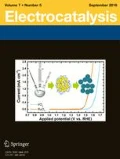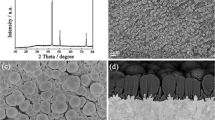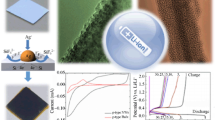Abstract
Lithium-ion cells are currently the most promising electrochemical power sources. New high-capacity electrodes made of silicon are presently under intensive study. Besides its high capacity, silicon undergoes a significant volume increase (up to 300%) during lithiation. The main research on the silicon-based electrodes is focused on the nanostructure development and capacity/life cycle measurements. Variations in other electrochemical parameters, SEI layer resistance and charge transfer resistance, are also important and give the information about structural changes and mechanisms of side processes that occur during an electrode lithiation/delithiation. This work presents electrochemical impedance spectroscopy measurements of three silicon–graphite composite electrodes, containing various silicon contents. A clear correlation between the SEI and charge transfer resistances and the active material lithiation level is presented. The effect of the cycle number on the measured parameters is also visible. We present possible mechanisms that lead to observed changes and highlight the requirement of the proper Si-based electrode formation and the correct estimation of operational parameters.

Schematic diagram of electrode structure and electrochemical parameters changing during lithiation and cycling










Similar content being viewed by others
References
R.E.F. Einerhand, High-energy non-aqueous batteries. Andrzej Cisak and Lidia Werblan, Polish Scientific Publishers and Ellis Horwood, Chichester 1993. Adv. Mater. 6(5), 421–422 (2004)
G. Kucinskis, G. Bajars, J. Kleperis, Graphene in lithium ion battery cathode materials: a review. J. Power Sources 240, 66–79 (2013)
M. Ratynski, B. Hamankiewicz, M. Krajewski, M. Boczar, D. Ziolkowska, A. Czerwinski, Impact of natural and synthetic graphite milling energy on lithium-ion electrode capacity and cycle life. Carbon N. Y. 145, 82–89 (2019)
A. Manthiram, An outlook on lithium ion battery technology. ACS Cent. Sci. 3(10), 1063–1069 (2017)
C. Heubner et al., Understanding thickness and porosity effects on the electrochemical performance of LiNi 0.6 Co 0.2 Mn 0.2 O 2 -based cathodes for high energy Li-ion batteries. J. Power Sources 419(December 2018), 119–126 (2019)
N. Nitta, F. Wu, J.T. Lee, G. Yushin, Li-ion battery materials: present and future. Mater. Today 18(5), 252–264 (2015)
M.A. Reddy et al., CFx Derived Carbon–FeF2 Nanocomposites for reversible lithium storage. Adv. Energy Mater. 3(3), 308–313 (2013)
F. Badway et al., Structure and electrochemistry of copper fluoride nanocomposites utilizing mixed conducting matrices. Chem. Mater. 19(17), 4129–4141 (2007)
T. Li, Z.X. Chen, Y.L. Cao, X.P. Ai, H.X. Yang, Transition-metal chlorides as conversion cathode materials for Li-ion batteries. Electrochim. Acta 68, 202–205 (2012)
C. Menachem, D. Golodnitsky, E. Peled, Effect of mild oxidation of natural graphite (NG7) on anode-electrolyte thermal reactions. J. Solid State Electrochem. 5(2), 81–87 (2001)
M. Koh, T. Nakajima, Electrochemical behaviors of carbon alloy BCx and of BCx-coated graphite prepared by chemical vapor deposition. Electrochim. Acta 44(11), 1713–1722 (1999)
M. Yoshio, R. J. Brodd, and A. Kozawa, Lithium-ion batteries: science and technologies. 2009.
R.J. Brodd, Batteries for sustainability (Springer Science, New York, 2013)
X. Sun, Y. Liu, J. Zhang, L. Hou, J. Sun, C. Yuan, Facile construction of ultrathin SnOx nanosheets decorated MXene (Ti3C2) nanocomposite towards Li-ion batteries as high performance anode materials. Electrochim. Acta 295, 237–245 (2019)
A. Ulvestad, J.P. Mæhlen, M. Kirkengen, Silicon nitride as anode material for Li-ion batteries: understanding the SiNx conversion reaction. J. Power Sources 399, 414–421 (2018)
Y. Xia et al., Theoretical study of electron transport properties of SimCn/Cn clusters tethered on graphene nanoribbon. Ceram. Int. 45(1), 530–538 (2019)
M. Martín-Gil, M.E. Rabanal, A. Várez, A. Kuhn, F. García-Alvarado, Mechanical grinding of Si3N4 to be used as an electrode in lithium batteries. Mater. Lett. 57(20), 3063–3069 (2003)
J. Yang, Y. Takeda, N. Imanishi, C. Capiglia, J.Y. Xie, O. Yamamoto, SiO x -based anodes for secondary lithium batteries. Solid State Ionics 152–153, 125–129 (2002)
T. Yim et al., Effect of binder properties on electrochemical performance for silicon-graphite anode: Method and application of binder screening. Electrochim. Acta (2014)
C. Pillot, “Lithium ion battery raw material supply & demand 2016-2025,” 2017.
H. Jia et al., Reversible storage of lithium in three-dimensional macroporous germanium. Chem. Mater. 26(19), 5683–5688 (Oct. 2014)
N. Hudak and D. Huber, “Nanostructured lithium-aluminum alloy electrodes for lithium-ion batteries,” 2011.
H. Tian, F. Xin, X. Wang, W. He, W. Han, High capacity group-IV elements (Si, Ge, Sn) based anodes for lithium-ion batteries. J. Mater. 1(3), 153–169 (2015)
M.N. Obrovac, L.J. Krause, Reversible cycling of crystalline silicon powder. J. Electrochem. Soc. 154(2), A103–A108 (2007)
A. Eftekhari, On the theoretical capacity/energy of lithium batteries and their counterparts. ACS Sustain. Chem. Eng. 7(4), 3684–3687 (2019)
M. Ratyński, B. Hamankiewicz, M. Krajewski, M. Boczar, A. Czerwiński, The effect of compressive stresses on a silicon electrode’s cycle life in a Li-ion battery. RSC Adv. 8(40), 22546–22551 (2018)
S. Hansen, E. Quiroga-González, J. Carstensen, H. Föll, Size-dependent cyclic voltammetry study of silicon microwire anodes for lithium ion batteries. Electrochim. Acta 217, 283–291 (2016)
J. Graetz, C.C. Ahn, R. Yazami, B. Fultz, Highly reversible lithium storage in nanostructured silicon. Electrochem. Solid-State Lett. 6(9), A194–A197 (2003)
C.K. Chan et al., High-performance lithium battery anodes using silicon nanowires. Nat. Nanotechnol. 3(1), 31–35 (2008)
Y. Tong, Z. Xu, C. Liu, G. Zhang, J. Wang, Z.G. Wu, Magnetic sputtered amorphous Si/C multilayer thin films as anode materials for lithium ion batteries. J. Power Sources 247, 78–83 (2014)
Y. Yi, G.H. Lee, J.C. Kim, H.W. Shim, D.W. Kim, Tailored silicon hollow spheres with micrococcus for Li ion battery electrodes. Chem. Eng. J. 327, 297–306 (2017)
S. Prakash, C. Zhang, J.D. Park, F. Razmjooei, J.S. Yu, Silicon core-mesoporous shell carbon spheres as high stability lithium-ion battery anode. J. Colloid Interface Sci. 534, 47–54 (2019)
M.H. Parekh et al., Encapsulation and networking of silicon nanoparticles using amorphous carbon and graphite for high performance Li-ion batteries. Carbon N. Y. 148, 36–43 (2019)
W.M. Dose, M.J. Piernas-Muñoz, V.A. Maroni, S.E. Trask, I. Bloom, C.S. Johnson, Capacity fade in high energy silicon-graphite electrodes for lithium-ion batteries. Chem. Commun. 54(29), 3586–3589 (2018)
V.G. Khomenko, V.Z. Barsukov, J.E. Doninger, I.V. Barsukov, Lithium-ion batteries based on carbon–silicon–graphite composite anodes. J. Power Sources 165(2), 598–608 (2007)
J.K. Lee, C. Oh, N. Kim, J.Y. Hwang, Y.K. Sun, Rational design of silicon-based composites for high-energy storage devices. J. Mater. Chem. A 4(15), 5366–5384 (2016)
G.M. Veith et al., Direct determination of solid-electrolyte interphase thickness and composition as a function of state of charge on a silicon anode. J. Phys. Chem. C 119(35), 20339–20349 (2015)
J. Zheng et al., 3D visualization of inhomogeneous multi-layered structure and Young’s modulus of the solid electrolyte interphase (SEI) on silicon anodes for lithium ion batteries. Phys. Chem. Chem. Phys. 16(26), 13229–13238 (2014)
K.W. Schroder, H. Celio, L.J. Webb, K.J. Stevenson, Examining solid electrolyte interphase formation on crystalline silicon electrodes: Influence of electrochemical preparation and ambient exposure conditions. J. Phys. Chem. C 116(37), 19737–19747 (2012)
B. Philippe et al., Nanosilicon electrodes for lithium-ion batteries: Interfacial mechanisms studied by hard and soft X-ray photoelectron spectroscopy. Chem. Mater. 24(6), 1107–1115 (2012)
C. Cao et al., Solid electrolyte interphase on native oxide-terminated silicon anodes for Li-ion batteries. Joule 3(3), 762–781 (2019)
M. Krajewski, B. Hamankiewicz, A. Czerwiński, Voltammetric and impedance characterization of Li4Ti5O12/n-Ag composite for lithium-ion batteries. Electrochim. Acta 219, 277–283 (2016)
M. Krajewski, B. Hamankiewicz, M. Michalska, M. Andrzejczuk, L. Lipinska, A. Czerwinski, Electrochemical properties of lithium-titanium oxide, modified with Ag-Cu particles, as a negative electrode for lithium-ion batteries. RSC Adv. 7(82), 52151–52164 (2017)
W. Wang et al., Silicon and carbon nanocomposite spheres with enhanced electrochemical performance for full cell lithium ion batteries. Sci. Rep. 7, 44838 (2017)
C. Li et al., Kinetics and electrochemical evolution of binary silicon-polymer systems for lithium ion batteries. RSC Adv. 7(58), 36541–36549 (2017)
S. Gao et al., From natural material to high-performance silicon based anode: towards cost-efficient silicon based electrodes in high-performance Li-ion batteries. Electrochim. Acta 327, 135058 (2019)
W. Xiao, C. Miao, X. Yan, Q. Sun, P. Mei, Enhancement of electrochemical stability about silicon/carbon composite anode materials for lithium ion batteries. J. Nanomater. 2015(1), 1–6 (2015)
T. Jaumann et al., Lifetime vs. rate capability: understanding the role of FEC and VC in high-energy Li-ion batteries with nano-silicon anodes. Energy Storage Mater. 6(August 2016), 26–35 (2017)
E. Radvanyi et al., Study and modeling of the solid electrolyte interphase behavior on nano-silicon anodes by electrochemical impedance spectroscopy. Electrochim. Acta 137, 751–757 (2014)
C.L. Berhaut et al., Multiscale multiphase lithiation and delithiation mechanisms in a composite electrode unraveled by simultaneous operando small-angle and wide-angle X-ray scattering. ACS Nano (2019)
A. Lasia. Electrochemical impedance spectroscopy and its applications. 2014
F. Ozanam, M. Rosso, Silicon as anode material for Li-ion batteries. Mater. Sci. Eng. B Solid-State Mater. Adv. Technol. 213, 2–11 (2016)
K. Feng et al., Silicon-based anodes for lithium-ion batteries: from fundamentals to practical applications. Small 14(8), 1702737 (2018)
M. Nie, D.P. Abraham, Y. Chen, A. Bose, B.L. Lucht, Silicon solid electrolyte interphase (SEI) of lithium ion battery characterized by microscopy and spectroscopy. J. Phys. Chem. C 117(26), 13403–13412 (Jul. 2013)
S. Dalavi, P. Guduru, B.L. Lucht, Performance enhancing electrolyte additives for lithium ion batteries with silicon anodes. J. Electrochem. Soc. 159(5), A642–A646 (2012)
O.O. Taiwo et al., Investigation of cycling-induced microstructural degradation in silicon-based electrodes in lithium-ion batteries using X-ray nanotomography. Electrochim. Acta 253, 85–92 (2017)
M.J. Piernas-Muñoz, S.E. Trask, A.R. Dunlop, E. Lee, I. Bloom, Effect of temperature on silicon-based anodes for lithium-ion batteries. J. Power Sources 441 (2019)
Acknowledgments
This project has received funding from the European Union’s Horizon 2020 research and innovation program, under grant agreement No 685716.
Author information
Authors and Affiliations
Corresponding author
Ethics declarations
Conflicts of Interest
The authors declare that they have no conflicts of interest.
Additional information
Publisher’s Note
Springer Nature remains neutral with regard to jurisdictional claims in published maps and institutional affiliations.
Rights and permissions
About this article
Cite this article
Ratynski, M., Hamankiewiecz, B., Krajewski, M. et al. Electrochemical Impedance Spectroscopy Characterization of Silicon-Based Electrodes for Li-Ion Batteries. Electrocatalysis 11, 160–169 (2020). https://doi.org/10.1007/s12678-019-00573-y
Published:
Issue Date:
DOI: https://doi.org/10.1007/s12678-019-00573-y




